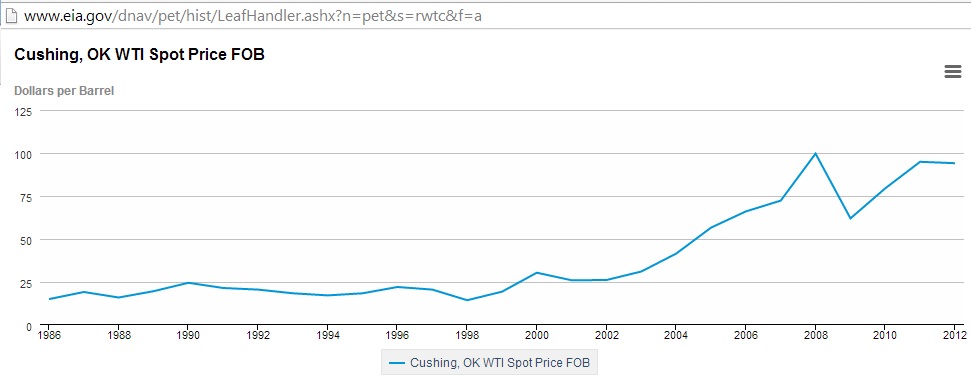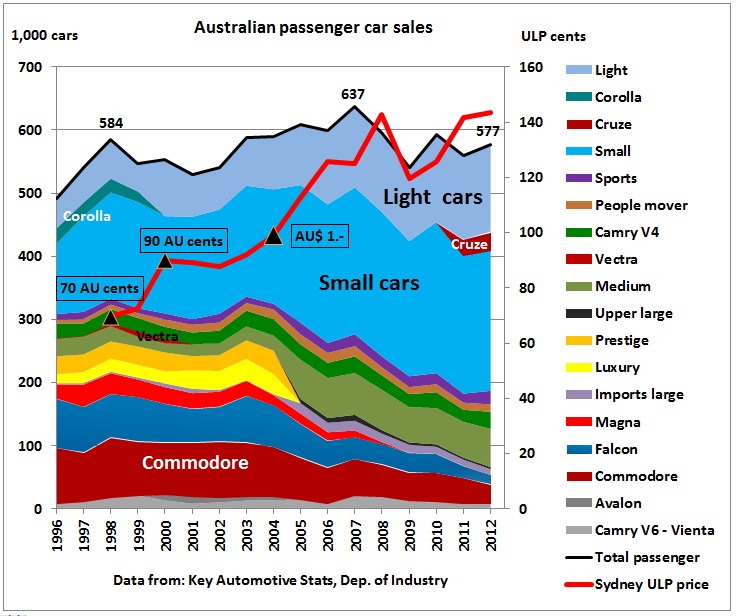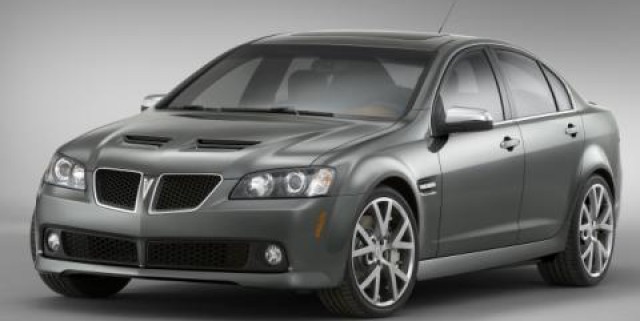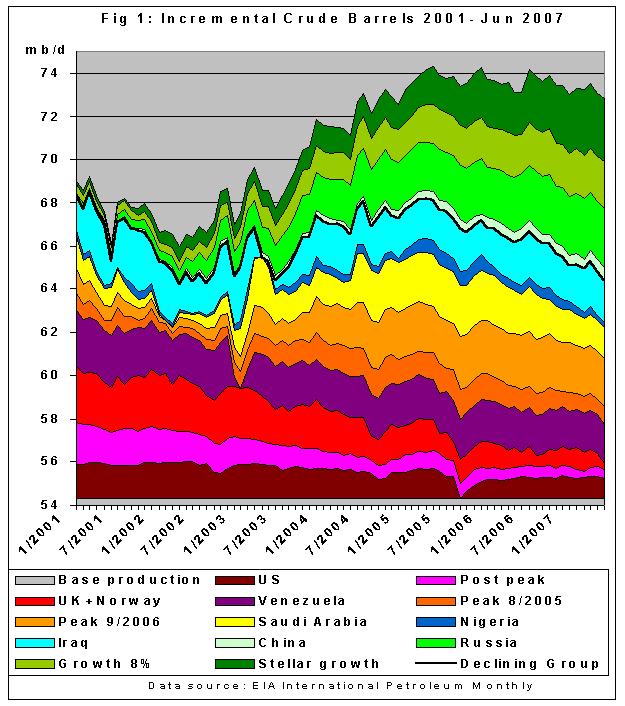GM Holden did not prepare for peak oil – since 1998
Part 1: The Howard years
Peak oil, which should be seen as a process having started in 2005 rather than an event in the year of maximum global production, hits the weakest first, those with a pre-condition of other problems. This post will show how ignoring early peak oil warnings by Irish oil geologist Colin Campbell led to mis-investments in the Australian car industry.
After Mitsubishi and Ford it’s now GM Holden which is closing its factory in Australia. Statistics of the Department of Industry show that sales of large cars in Australia peaked way back in 2003, the year of the Iraq war which was designed to use Iraqi’s oil to push the global peak a couple of years into the future. Only months before then Prime Minister Howard joined the collation of the peaking he announced a13 year long assistance package for the Australian car industry – without introducing mandatory fuel efficiency standards for car fleets.
Holden’s demise was sealed in 2009 at the height of the financial crisis which was triggered by high oil prices. In that year the US government forced GM – as a condition of its bail-out – to dump the Pontiac brand, for which Holden’s VE Commodore SS was planned to play a major role. Local production of the Cruze came too late. So we have peak oil ignorance being punished all the way to the very end – without any chance for a transition to e.g. the much hyped fuel cell technology.
Why is this all so important now? When looking at Holden’s Commodore history, it took 6 years to develop the VE model with V6 and V8 engines. Production started in 2006. It may have been a good car but it came at the wrong time because no one told Holden about peak oil. It took another 7 years until decisions made much earlier led to Holden’s closure.
The same losses will happen again now with many additional oil-dependent project proposals (like road tunnels and airport expansions) which are based on 10-20 year old plans.
(1) GM Holden’s announcement to close down
Holden to cease manufacturing operations in Australia by 2017
12/1/22013
“Australia’s automotive industry is up against a perfect storm of negative influences, including the sustained strength of the Aussie dollar against almost all major trading currencies, the relatively high cost of production and the relatively small scale of the local domestic market,” Mr Devereux said.
(2) Holden’s problems started more than 10 years ago
The perfect storm had come much earlier than a high Australian dollar which went above earlier 1990 levels of 75 US cents only after 2007
It was high oil prices which started to exceed permanently the $20 a barrel level in 2002:
That changed the whole car market for good:
Australian passenger car sales are on a bumpy plateau since 1998 with an average of 580 K per annum. There was a peak in 2007 and sales in 2012 were slightly lower than in 1998, despite population increasing by 21% over this period. Light and small cars increased their market share of 43% in 2003 to 68% in 2012. The graph shows that when petrol prices exceeded the psychological $1 mark things changed fundamentally.
The 2007 sales peak and the drop in 2008 can also be seen in the following graph of the ABS showing the average vehicle age.
A continuing improvement since 1998 ended in 2008 when the curve started to flatten.
So the turning point for Australian medium and large car sales was 2003, the year of the Iraq war. First peak oil warnings came from Irish oil geologist Colin Campbell in 1996 and then again in 1999 in a presentation to the House of Commons.
Presentation to a House of Commons All-Party Committee on July 7th 1999
THE IMMINENT PEAK OF WORLD OIL PRODUCTION
That happened under John Howard’s watch and – given Australia’s special relationship with UK – . ONA should have picked that up. At that time a bill was being drafted with the objective to help the Australian car industry with surviving a series of tariff cuts. It would have been easy to make that assistance dependent on the introduction of fuel efficient cars but this was not done as can be seen in the following legislation.
(3) Automotive Competition and Investment Scheme
The Howard government which had come to power in March 1996, introduced following legislation:
(3.1) ACIS legislation
Bills Digest No. 10 1998-99 Customs Legislation (Automotive Competitiveness and Investment Scheme) Bill 1998
August 1998
The purpose of ACIS is to provide transitional assistance to the Australian automotive industry leading up to the deadline for Australia’s obligations under the APEC(3) free-trade agreement. The APEC deadline for free-trade is 2010.
Australia’s production of PMVs accounts for less than one per cent of global production, which is currently headed towards 50 per cent overcapacity.
Financial estimates are subject to variables including the impact of the current Asian financial crisis, exchange rates, world and domestic market growth rates and consumer choice for imported vehicles.
Related matters
World greenhouse concerns have added pressure on carmakers to reduce vehicle weight and fuel consumption by significant degrees. This may indirectly strengthen the position and marketing options available to those manufacturers specialising in small vehicle production.
The scheme commenced in January 2001. ACIS provided $2.8 bn import credits for eligible car and component manufacturers up to 2005, to offset the cost of tariffs for imported cars.
(3.2) Productivity Commission Inquiry 2002
Inquiry into Post-2005 Assistance Arrangements for the Automotive Manufacturing Sector
In March 2002 the Federal Treasurer Peter Costello asks the Productivity Commission to conduct an Inquiry into the performance of ASIC and the design of the next phase after 2005
(3.2.1) Holden submission May 2002
Holden made following main points in relation to fuel costs, efficiencies and commercial production thresholds:
- In terms of technological change alone, the automotive industry is on the brink of a major shift as we make the transition from internal combustion engines to fuel cells. (p 10)
- Despite “occasional price spikes”, fuel costs have not affected vehicle sales but a “sustained increase in petrol prices above the ‘mental’ price point of $1/litre may affect the demand for large vehicles with 6 and 8 cylinder engines over the longer term” (p18)
- “The large car segments are shrinking around the world due to various factors ranging from the cost of a parking space to fuel costs (particularly in Europe) and environmental considerations.” (p 20)
- An annual manufacturing volume of at least 180,000 units based on a single platform is required for an Australian plant. (p 20)
- “For viability it is necessary to achieve domestic sales in Australia of well over 100,000 units from a single platform. The only segment, in which this is possible, is the large popularly priced rear wheel drive segment.” (p 21)
- “The large low-priced rear drive segment is a niche market in every country in the world except two: Australia and Saudi Arabia. Export sales of in excess of 50,000 units per year are eminently possible from an Australian production base. Conversely, the location of large, low-priced, rear drive passenger car production in any country except Australia is impeded by the small domestic opportunity in each such market. Hence, this product type is probably the only passenger vehicle for which world production would logically be located in Australia” (p 21)
- “The opportunities for Australian vehicle manufacturers in markets such as Thailand are relatively small, given Australia’s specialisation in large cars and a tax system in Thailand that discriminates against such vehicles. However given the growth potential of ASEAN markets over the next decade or two, participation as a niche supplier could progressively become attractive. Meanwhile Thailand’s own industry primarily produces light trucks – a segment in which Australian production is fairly narrowly specialised.” (p 42)
- “The National Average Fuel Consumption Target of 15% over business as usual by 2010 has been under discussion between the industry and the Government for some years. The industry has proposed two “Co-operative Targets” of 6.8 litres per 100km by 2010, and 6.3 litres per 100km by 2015. These targets represent a significant challenge when compared to the “Achievable Target” of 7.4 litres per 100 kilometres that had previously been identified. Clearly, whether these targets can be achieved will depend on a range of factors including availability, costs and uptake of relevant technologies, availability and quality of fuels, consumer preferences and policy settings. In particular, the industry has identified the need for Government participation, requiring that it work closely with industry to achieve a policy framework in which consumers value fuel efficiency improvements sufficiently to choose to purchase them, without sacrificing their existing preference for large cars which is the basis for the industry’s viability” p 43
- “Holden’s research consistently shows that consumers do not value improved fuel efficiency highly. At least in a relative sense, fuel efficiency ranks relatively low when compared to other vehicle attributes such as performance, towing capacity, features and safety. This can be attributed in the main to the relatively low cost of fuel in Australia, and it appears unlikely that this will change in the short to medium term. What it means in practical terms is that if we are required to incorporate new technologies into our vehicles that the consumer does not value, we will obviously not be in a position to recover the cost of those technologies in the price of the vehicles. Ultimately, this will have the effect of rendering our vehicles less competitive in the marketplace” (p 44)
- “In Holden’s view the preferred method for encouraging an increased consumer emphasis on fuel economy would be a gradual and moderate increase in fuel excise, which would send an appropriate signal to consumers without causing economic or industry disruption. However, we understand that this may not suit political realities in Australia.” (p 44)
(3.2.2) Submission of Federal Chamber of Automotive Industries, May 2002
It is interesting to read how the FCAI saw the future 2012-2017:
Hybrid powered vehicles are already on our roads and within the next 10 to 15 years the huge investment in R&D on fuel cell technology will have paid off and it is generally believed will have moved t o widespread application almost completely replacing petrol driven engines. (p 13)
(3.2.3) Australian Greenhouse Office submission May 2002
The following graph shows fuel efficiency targets. NAFC = National Average Fuel Consumption
..
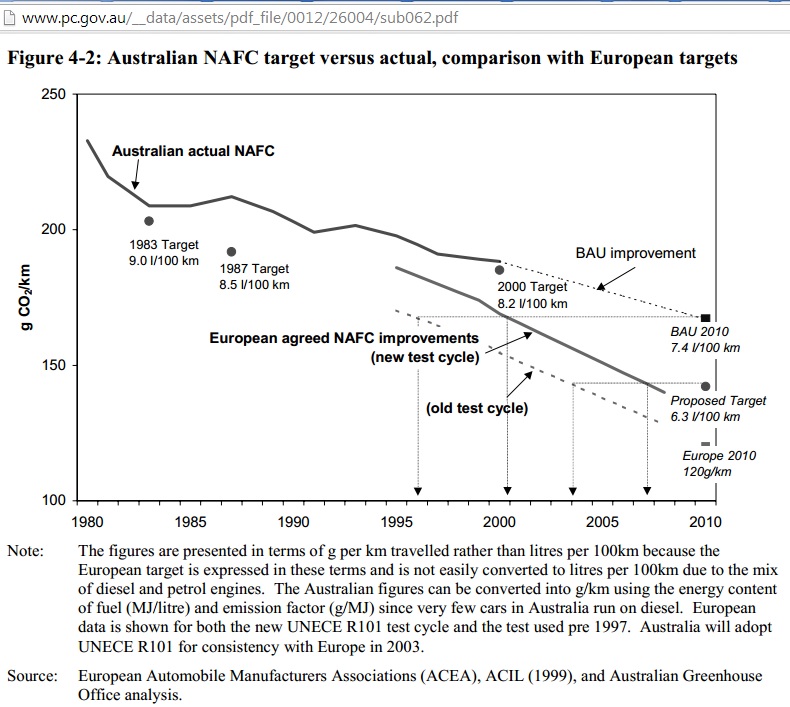
(3.2.4) Productivity Commission Report August 2002
These were the main points:
- Fuel consumption targets must have regard to the level of improvement in the fuel efficiency of local vehicles that can be achieved without compromising the commercial viability of domestic production. (pXXXVIII)
- Collectively, the Middle East, the USA and New Zealand take around 75 per cent of Australia’s automotive exports (table B.15). Again, this narrow export base is regarded by some as a potential threat to the industry’s future viability (p 28)
- The majority of Australia’s vehicle exports currently go to the Middle East.. Further opportunities may arise in that market — particularly for larger engine, rear-wheel-drive models which appear well suited to customer requirements. However, some have suggested that this market is now close to being saturated. The political situation in the region also creates some inherent risks for these exports (p 34)
- Prospects for vehicle exports to Asia are less certain: (p34)
- while demand is expected to grow strongly in the region, much of that growth will be for smaller passenger and light commercial vehicles
- access to many Asian markets is currently restricted by high tariff and non-tariff barriers; and
- the major vehicle producers are generally seeking to service these markets through investment in local production facilities — partly as a result of trade barriers and the availability of investment incentives.
Threats to the industry’s future viability
- Appreciation of the currency would reduce the cost of imported inputs used by automotive producers. But at the same time, it would increase the competitiveness of imported vehicles and components in the domestic market and reduce the competitiveness of Australian automotive exports. Not surprisingly, the capacity of firms to cope with any significant future appreciation of the Australian dollar — against the $US and Yen in particular — appears to vary considerably. Some companies indicated that future appreciation of the local currency would be a bigger threat to their future viability than reductions in tariffs.
There is a range of other potential threats, including …
- price suppression in world automotive markets as a result of continuing and substantial excess production capacity;
- changes in global sourcing decisions, or economic downturns, political instability or unrest affecting the industry’s major export markets;
- the looming change from petrol and/or diesel to fuel cell propulsion technology over the next two to three decades;
- erosion in the domestic supply base as a result of any further significant increase in the import share of the local vehicle market;
- the exit of a vehicle assembler or major component producers
- failure to undertake further taxation reform and microeconomic reform to improve efficiency in Australia’s infrastructure industries ;
- the introduction of overly stringent fuel economy targets; and
- uncertainty about future policy settings for the industry.
Most critical factors were mentioned except petrol prices as a result of limited oil supplies.
(3.3) Media presentation on future of ACIS
Howard removes the auto industry’s trainer wheels
December 14 2002
Car and component makers have enough confidence, and exports, to handle tariff cuts
Australia’s emergence as a car exporter has been one of the Howard Government’s two success stories in manufacturing. And John Howard and Industry Minister Ian Macfarlane clearly do not want to risk ruining it now.
Yesterday the PM and his minister stood flanked by the heads of the four car companies and leaders in the component industry as they announced a plan to phase out support for the industry – at a pace manufacturers believe they can handle.
Unlikely as it once seemed, Australia has a growing car industry with a global niche in producing large cars. For that we can thank the devaluation of the dollar, large-scale government support for the industry under the Automotive Competitiveness and Investment Scheme (ACIS), plus the spade work done by former Labor industry minister John Button and the car companies.
Essentially the government plans to pull back support in three stages. In 2005, the tariff falls from 15 to 10 per cent, and ACIS spending continues at $560 million a year. In 2010, the tariff falls to 5 per cent, and ACIS reduces to $280 million a year. At the end of 2015 the tariff stays but ACIS goes.
13 December , 2002
JOHN HOWARD: A new feature of the ACIS scheme after 2005 will be a $150 million research and development fund to assist vehicle manufacturers in developing new advanced technologies
It is a transformed industry, one that is performing well. I want to thank the management of the motor vehicle companies. Can I also thank the workforce, the Australian Manufacturing Industry in motor cars is very important to the future of the thousands of Australians, especially in Adelaide and Melbourne
(4) No fuel efficient Holden manufactured in Australia by 2003
That self-congratulation was both premature and peak oil ignorant. Another chance was missed to introduce fuel efficient cars.
At that time, Holden was importing the Astra from Belgium. Why was that model not manufactured locally?
All the while the Howard government was busy preparing to participate in the Iraq war which had the objective of un-locking Iraq’s oil which was capped by the Oil-for-food programme. But the military intervention backfired and petrol prices took off.
As a result of policy failures going back to 1998, Holden did not have a locally manufactured, fuel efficient car when petrol prices went higher than $1 a litre in 2004. The Cruze came much too late.
(5) Opel Omega production ends in Germany in 2003
GM Holden’s Commodore was based on the Opel Omega until 2006 when an Australian developed platform was introduced.
The Omega production in Ruesselsheim (near Frankfurt) ended in 2003 due to lack of demand, without immediate successor. The 4-cylinder engines were too weak for such a big car and the 6-cylinder engines were too thirsty. Also, the Omega was no match for the BMW 5 series.
(6) Howard’s peak oil ignorant 2004 energy white paper
In June 2004, the Howard government released a completely peak oil ignorant energy white paper. It contained 2 flawed statements:
(1) “Despite increasing demand for oil, there are sufficient reserves to supply world demand for around 40 years”; page 119
(2) “The above factors mean that there is currently no case for the government to accelerate the uptake of these [alternative] fuels on energy security grounds. To do so would involve additional costs for consumers, with few energy security benefits”; p 124
The following actions of the government provide for fuel standards which are entirely voluntary:
The government has in place a National Average Fuel Consumption agreement with the car industry. This agreement involves a target of reducing the average fuel consumption of new cars sold in Australia from 8.43 litres per 100 kilometres to 6.8 litres per 100 kilometres by 2010. (p 112)
The government continues to publish an annual fuel consumption guide for new vehicles, and since 2001 new vehicles have been required to carry a fuel consumption label. The Australian Government will also widely promote the Green Vehicle Guide, providing a simple, integrated environmental assessment of motor vehicles. This information will allow new car buyers to consider environmental performance in their purchasing decisions and contribute to reducing transport emissions. (p 156)
In the long term, hydrogen could provide an environmentally friendly fuel alternative, although significant developments in safety, cost and technologies for producing and transporting hydrogen will be required. Transport issues are complex and closely related to lifestyle choices. All countries have found it difficult to effectively manage greenhouse emissions from the transport sector. (p 137)
10 years down the track the hype about fuel cells and a hydrogen economy has not come far. Expenditure to promote green vehicles was minimal:
More details on oil supply issues can be found in this post:
(7) The VE Commodore in 2006
16/7/2006
Holden today (16th/July) unveiled the all-new Holden VE Commodore range. The 2006 VE Commodore is Australia’s first $1 billion car program and the most homegrown development project in almost 60 years of Holden vehicle production.
Holden spent more than six years planning and developing the new VE Commodore, the first generational change since the VT Commodore was launched in 1997.
The VE program totalled $1.04 billion and the WM Statesman and Caprice program $190 million, taking the combined cost to $1.23 billion.
(8) Senate Inquiry on future oil supplies
In the same month, Iranian oil expert Dr. Samsam Bakhtiari gives a lecture on peak oil to a hearing of the Senate Inquiry on future oil supplies in the NSW Parliament House in Sydney
11/7/2006
Dr Samsam Bakhtiari—It is extremely difficult to forecast precisely the price of oil in the future. I can see a range of $100 to $150 not very far into the future.
Senator JOYCE—That is $100 to $150 a barrel?
Dr Samsam Bakhtiari—Yes, this we are certainly going to get to. In my opinion, we could get there very easily. We are a couple of hurricanes or some geopolitical problems or a war away from having a worse problem than we have today.
In the same hearing ASPO member David Kilsby answers a question:
Senator JOYCE—What if we do not deal with the fact that the internal combustion engine is a major driver in the economy and, therefore, we need fuel that is compatible to that internal combustion engine?
Mr Kilsby—That is going to be quite difficult to do. I think the longevity of the car fleet is one of the problems we have. It will probably take 20 years to turn over. The car industry is putting a lot of thought into what it can sell us in years to come, obviously. One of the big hopes of the car and energy industries is that we will be able to switch from an oil based economy to a hydrogen economy, which is one of the things we have heard about. But it will probably take decades before a commercially available hydrogen fuel cell car becomes available, and I do not think that is time that we have
7 February 2007
The final report by the Senate Standing Committee on Rural and Regional Affairs writes on peak oil:
1.3 The inquiry was prompted by the question whether Australia should be
concerned about ’peak oil’…Proponents of peak oil arguments commonly predict a peak somewhere between now and 2030. They suggest that this could cause serious economic hardship if mitigating action is not started soon enough.
Recommendation 2
3.145 The committee recommends that in considering a less oil dependent policy scenario, the Government take into account the concerns expressed in the World Energy Outlook 2006, namely –
- current trends in energy consumption are neither secure nor sustainable;
- energy policy needs to be consistent with environmental goals, particularly the need to do more to reduce fossil fuel carbon dioxide emissions. (p 56)
Consequently, the Committee deals with fuel efficiencies of vehicles.
8.16 Other suggestions made in submissions to improve fuel efficiency of cars included:
- measures to encourage smaller and hybrid vehicles in government and similar fleets
- measures to encourage diesel cars, which are more expensive than similar petrol cars but much more fuel efficient (they use 30-50 per cent less fuel than petrol cars of similar power)
- measures to encourage smaller cars, for example by adjusting registration fees to favour them
- removing the concessional tariff treatment of imported four wheel drives and
- increasing the fuel excise as an environmental measure. This could be coupled with lower registration charges to be cost neutral overall. It would reduce the flagfall cost of car ownership but increase the marginal cost of a trip, and so would be expected to encourage more fuel efficient cars and reduce the kilometres driven. (p 146)
8.20 …… The committee is concerned at the slow rate of improvement in the fuel efficiency of the light vehicle fleet, and the apparent uncertainty about what has been achieved to date by the current industry voluntary code.
Recommendation 6
8.21 The committee recommends that the Government, in consultation with the car industry, investigate and report on trends in the fuel efficiency of the light vehicle fleet and progress towards the 2010 target for the fuel efficiency of new passenger cars. If progress under the present voluntary code seems unlikely to meet the target, other measures should be considered, including incentives to favour more fuel efficient cars; or a mandatory code. (p 147)
(9) GM Holden prepares VE Commodore for US market
In the same month the Senate Committee handed over its final report, Holden announces the US versions of its 3 ltr V6 and 6 ltr V8 models which it had started to manufacture in July 2006. The VE was the first Commodore not based on the Opel Omega which GM Germany had dumped in 2003. As a result, VE development costs were very high, as already mentioned above.
VE Commodore SS becomes the Pontiac G8 GT
Feb 8, 2007
(10) Crude oil production declines 2005-2007
In 2007 it became evident that crude oil production was declining since 2005. Together with Gail the Actuary I wrote this article in the Oildrum blog:
Did Katrina hide the real peak in world oil production?
Oct 2007
We calculated that crude production in Dec 2005 would have peaked at 74.7 mb/d without hurricanes Katrina and Rita.
At that point in time it was immaterial that oil production would pick up again later. High oil prices had already started to damage the economy and the US went into recession by end 2007.
The Howard government was not concerned with peak oil. Nevertheless, voluntary fuel efficiency targets were introduced, but packaged as a way to reduce CO2 emissions. In 2007 the IPCC 4th report was published and climate change became a issue at the November 2007 election which Howard lost.
(11) The present: back to square one
Not that Howard had really understood global warming, let alone peak oil. CO2 reduction and higher fuel efficiencies were only seen as a political response to the concerns of the public, not as a real, physical problem to be solved as quickly as possible. This has been confirmed recently, now that Howard’s protégé Tony Abbott has become Prime Minister:
6/11/2013
Howard’s speech described the advocates of climate change mitigation as “alarmists” and “zealots” for whom “the cause has become a substitute religion”. He said “global warming is a quintessential public policy issue” and policymakers should not become subservient to the advice of scientists.
We haven’t heard from the new Liberal government that peak oilers are alarmists but action on peak oil is unlikely:
Conclusion
The Holden history tells us that wrong decisions were done 10-15 years ago. The 2005 Hirsch report to the US Department of Energy warned it would take 10-20 years to prepare for peak oil. This time has been wasted by Australian governments and the car industry by continuing what was essentially business-as-usual. The unexpected US shale oil boom resulted in global crude production in 2013 getting higher than 2005 but this did not reduce oil prices – although it might have helped to stop oil prices from skyrocketing beyond experience.
If you think that lessons have been learned for other oil-dependent sectors of the economy you’ll be disappointed. The equivalent of the love affair with big cars and 3 litre engines is the continuing push of governments for additional highways, toll-ways and road tunnels instead of electric rail development.
To be continued in part 2: How the Rudd/Gillard governments failed to deal with peak oil and the survival of the Australian car industry
Related posts:
Stop sign teaser image via shutterstock. Reproduced at Resilience.org with permission.




